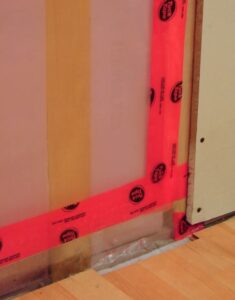Insulation Basics – Vapor Barriers
 When you are thinking about installing insulation you also need to think about Vapour Barriers.
When you are thinking about installing insulation you also need to think about Vapour Barriers.
Although I frequently saw mention of vapor barriers in books and articles it was a long time before I understood why there were needed……………. Here is my explanation:
- Warm air, inside the house, contains a lot of moisture (water vapor) which comes from people breathing, cooking, showers, flueless gas or oil heaters, and house plants.
- If this air is allowed to pass through the building structure it cools.
- As the air cools it can’t hold as much moisture and water condenses in the structure and in the insulation.
- The water can:
- Waterlog the insulation reducing its effectiveness.
- Cause rot in wood.
- Cause corrosion, Particularly on the underside of a metal roof.
To stop the problems you put a vapor barrier………….Which is really an airtight barrier……….on the inside face of any insulation.
An Exception
You Don’t usually need a vapor barrier on the ceiling if you have a ventilated roof space as the air flow above the insulation will dry out any moisture in the insulation.
Cathedral ceilings and flat roofs are a different matter and Do Require a vapor barrier as there is no ventilated space above the insulation.
Types of Vapour Barriers
Vapor barrier don’t have to withstand any pressure so they can be quite thin. Examples are;
-
- Polythene sheet,
- Reflective foil,
- Foil backed plasterboard,
- Water resistant painted surfaces,
- Impermeable insulation such as sheets of polystyrene.
All joints and overlaps in the vapor barrier should be taped or glued to make sure no air gets through.
See Insulation for similar Posts
For Posts about Green Building see Sustainability
For more about Moisture Problems see this link: Condensation.